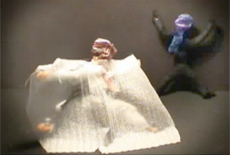Sept 1, 2007
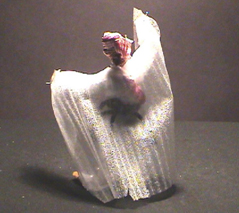
Although I am a mere beginner in the world of animation, my recent short interlude in animating little figures and drawn images has revealed to me that the art of animation is closely related to the art of process work. In fact, my newly found interest in animation has helped me appreciate and illuminate a central aspect of process work in a simple and artistic way.
Stop-Motion Animation
I am sitting with a little figure that I have made from pipe cleaners and fabric. She is about 5 inches tall. I place her with her back towards me on a makeshift stage. She has a cape, white clothes, and a headdress. We pause. Just the two of us; waiting for the mystery to show us the way.
Suddenly I feel, sense, or perhaps see a subtle motion of the figure. I have the distinct feeling that she wants to move ever so slightly to the right. She seems to have a life of her own and knows where she would like to move. I am her assistant and dutifully follow.
I move her a tiny bit and take a picture with the still-image part of my video camera. Returning again to the figure, I sense her next impulse, her next movement tendency, and move her ever so slightly in that direction. I click the camera again. I repeat this process numerous times as she continues to show me how and where she wants to move.
That is a core belief of mine as well. Aboriginal people around the world have always said that there is life in seemingly inanimate things. The world is alive and animated; full of dreaming. If you look at a rock and see a face in it, you and the rock begin to “dream together.” When you know that even inanimate objects have a life of their own, you discover new worlds and new sources of creativity.
* * * I continue to sense, move, and click photos of my little figure. After what seems like eternity -- though it is probably only about half an hour -- I know that the dance is done. She has come to a resting spot. We both sigh deeply.
Without thinking much I rewind the video tape in order to play the sequence back. Because I am new to the world of stop-motion animation, I expect I will see a bunch of disjointed static postures progressing awkwardly from one position to the next. Although this is somewhat true, I am nevertheless astonished by what I see. As the video camera plays, it feels as though the individual photos become unleashed from their static poses – and my little dancer begins to flow and move through time. She transforms into a living, breathing being with a life and expression of her own. What was once a seemingly “lifeless” figure begins to move through space and time as if she has always been dancing. Watching her takes my breath away. (To see this video, go to http://www.youtube.com/watch?v=q8wQzqHjnIs)
Calculus and the Dance
A connection comes to mind. In his book Quantum Mind,i Arny writes about the math behind physics and, in particular, about the origin of calculus in mathematics. I should say that, for my mainly artistic and feeling personality, calculus is very far from my everyday identity. (Actually, I liked studying calculus in high school but have since forgotten everything I learned about it!) But, I was excited by his description and understanding of calculus and the way in which it illuminates a fundamental concept of process work.
To make things simple, Arny speaks about the measurement of velocity when, for example, a person travels from one fixed point to another. When the distance between these two points becomes infinitesimally small, what Isaac Newton would call approaching the “limit” of almost nothing, it becomes impossible to calculate the speed. Newton wanted to know what the meaning of speed is at a given point. At that point, the person traveling at a given speed is no longer traveling from one point to another but is in the midst of a fluid process. Newton called his method of calculating this fluid motion the “fluxion” method. Arny says of this phenomenon:
[We] moved from a fixed or state orientation of assessment of discrete steps measured accurately in terms of distances and times to an immeasurable world with a process orientation.ii
Arny likens this transformation to the process of learning to dance! He says that to learn to dance, you learn certain fixed steps and try to remember them. But once you know them, you begin to flow. You are no longer doing the steps, you are dancing, flowing in a fluid process that can no longer be described as a bunch of individual steps, or in the case of animation, still images. This is an old and beautiful description of the process of my little figure. Who would have known that calculus could help explain her flowing movements, her process, her dance?
State and Processes
State and process orientations are at the core of process-oriented thinking and practice. A state-oriented approach to life focuses, in general, on the individual “photos” of your life, on the particular things that you do or have done, the identities and roles that you have had, etc. A process-oriented approach, on the other hand, focuses on the flow between static images. When you move in that flow, the lines between the still images blur into an experience, into a dance that begins to unfold itself. As you begin to dance, Arny says, you step into your dreaming process, the fluid and immeasurable river moving within you. Ohhh, what a feeling!
When I am in a state-oriented mood, I define myself in a specific way. I say I am this or that kind of person. When I was in college I identified as a dancer. Click! Today I identify as a therapist. Click again! When I am in a process-oriented mood, I know that the beauty and mystery of who I am is a flow between these states. I am all of these individual pictures of myself and, at the same time, I am the process between them, the flow of my experiences from day to day, from picture to picture. I am the dance between points; always in the process of unfolding.The Simplicity of Process Work and the Process of Becoming
The simple analogy of stop-motion animation applies beautifully to following each of our inner processes. Each of us is a “little figure,” so to speak, with this and that identity, certain clothes, a profession, etc. When you want to practice the “art of process work,” you need only step into the animator’s mindset. You then ask, what slight movement, what little tendency is trying to happen just now inside of me? What part of me is in the midst of, or just beginning to, flow? Even if you feel very stuck, ask yourself what slight thing is happening that is not quite static; trying to come to birth. In other words, what do I notice within myself that is in process?
Whether you work on yourself alone or with someone else, you can simply notice the mysterious, slight tendencies that seem to be suspended in the air; slight motions, sounds, gestures, breaths that are beginning to go somewhere but haven’t yet unfolded their path. In other words, notice what is in the process of becoming.
As you become aware of these tendencies, step into them; help them flow and “dance.” Gently beckon them to express themselves more fully, to come to birth. Then you discover hidden dances full of wisdom and meaning. Of course, this process orientation requires temporarily stepping out of your static experience of yourself to allow the flow to emerge. However, once it has, the dance has the potential to enrich and renew your everyday life.
Consider the woman who told me that she is depressed. Her speech was slow; she cried and said that she felt sad and down. She was feeling overwhelmed by a huge amount of details in her life. In a fleeting moment she looked up and saw a bird flying by the window. She gasped at its beauty but then began to talk once again about her problems and how she felt unable to solve them.
As an animator (a process worker), I begin to wonder what aspect of her experience is just beginning to reveal itself? Much like my experience with my animated figure, I can ask, what slight tendency is happening and wants to be expressed? I remembered the moment she looked up at the bird.
I encouraged her to recall that moment and imagine further into that bird. She paused and said that she imagined that the bird was utterly free. Simultaneously, she began to make little motions with her hands like the bird flying high over buildings. With a bit of encouragement to go further with her movement, she experienced herself as a winged being with greater overview and freedom. She then realized that she had been too caught up in everyday life events and details. As the bird she had a greater overview of her life and where she was heading. She was greatly relieved by this fluid image. In a sense, she went from the static picture of sadness and overwhelm, to the dance of a bird with great height and detachment.Body Symptoms
Body symptoms are often experienced as static, miserable states! A headache, for example, is a staticexperience– and usually indicates the need for an aspirin! But as an animator, you can seek the slight movement happening within the headache, within any body symptom.
I recently had a headache. You could leave it at that, but I’d rather that you ask me to describe my headache. I would tell you that it feels as if there is something pressing on my head with great force. These words indicate dynamic pressures and processes -- rather than static states –and reveal to me that there is an intense drama going on in this poor little head of mine! If I actually show you with my hands what that pressure or force is like, all sorts of stories, images, feelings, dream figures, and experiences arise. Suddenly I find myself in the beginning of a new journey. I am in the midst of a dance that is flowing between the headache and the aspirin! So, where is it going? What is the dance trying to express?
In my own experience, as I made the gestures of pressure with my hands, I had a fantasy that a huge rock, like a boulder, was pushing on my head. I began to play as if I were that rock. The rock “spoke” to me and said that I should go ahead with my work, that I shouldn’t be deterred by my doubts. I realized that I have been hesitant to undertake certain creative projects because I feel that they are too big, and I won’t be able to do them well enough. The rock, on the other hand, said that it doesn’t worry about such things. It has the force to create change and fulfill dreams. I continued dialoguing between myself and the rock and discovered its power; a special inner centeredness that would allow me to stay very close to my inner dreams and bring my creative ideas to birth, regardless of my uncertainties.
The Dance and Double Signals
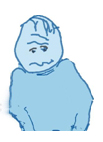 Each of us is like an animated figure whose process expresses itself in body symptoms, sudden fantasies, and everyday body signals. Some signals are static in the sense that they are congruent with the way we speak about ourselves. They don’t seem to be moving, but are clear and understandable. Think of Willy, one of
Each of us is like an animated figure whose process expresses itself in body symptoms, sudden fantasies, and everyday body signals. Some signals are static in the sense that they are congruent with the way we speak about ourselves. They don’t seem to be moving, but are clear and understandable. Think of Willy, one of
If we watch Willy closely, we notice that at the moment when someone criticizes him, he looks afraid but at the same time his arms inadvertently
rise up to his hips. What is that movement about? It seems like his arms are beginning a dance, but we don’t know where they are going or what this gesture means! This body signal is in process. We call these unintentional signals that we cannot readily understand, double signals—that is, experiences in the midst of unfolding.
To enter Willy’s process, we need only encourage him to focus on his double signal and find out where it is going. When Willy explores the feeling of having  his hands on his hips, he begins to feel strong and suddenly imagines that he is a very tough character to be reckoned with! You can see Willy’s song and video at: http://www.youtube.com/watch?v=Z9l8EQHbI8g
his hands on his hips, he begins to feel strong and suddenly imagines that he is a very tough character to be reckoned with! You can see Willy’s song and video at: http://www.youtube.com/watch?v=Z9l8EQHbI8g
When Willy goes deeper and unfolds his “dance” even further, he discovers that the essence of this strength is like being a mountain standing tall, solid, and proud. Standing proudly, he said that he felt like a great elder who could support himself and also support his opponent!
Creativity, Flirts, and My Film
For me, process work is both a form of therapy and a creative art form leading to innovative and artistic pathways. In my first animated film, The Stars at Night (see http://video.google.com/videoplay?docid=-9155821734280508549), my hope was to inspire each of us to dream; to realize that creativity is right there in the subtle motion within and around you. All you have to do is notice something that is beginning to dream itself into life, that seems to pop out of the nighttime sky, and assist its unfolding.iii
Creativity can begin by simply noticing the slightest thing that catches your attention as you walk down the street; little flirts, as Arny calls them, that grab your attention. The bird that caught the woman’s attention, above, was a flirt and the beginning of a dance. When you catch these fleeting experiences, you can bring them to birth in artistic form and discover their insights about enriching everyday reality.
The majority of animated pieces in my film arose out of little flirts that popped out of that “nighttime sky”: short musical phrases that jumped into my head or quick
For example, one day while sitting outside, I suddenly had a fleeting vision of two children on a hilltop, looking up at the sky. I made a very simple drawing of this image. With that vision in mind, I sat down at the piano and started to play some chords and eventually wrote my song “I Look Up into the Sky.” As I let the process unfold further, I drew more images and finally merged the pictures together with the music to create a short music animation. (See this video at http://www.youtube.com/watch?v=8NDbS6zR5O8)
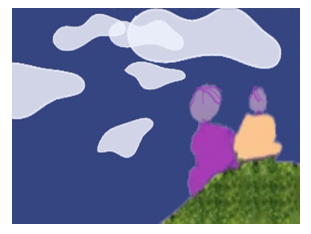
At another time I was looking at a puppet I had recently created from cotton and a stocking. As I looked at him I could have sworn that he said that he was the maestro of a symphony orchestra! I held on to this fantasy, let myself dream into him, and suddenly had the flickering idea to create a documentary about his life! I knew it was absurd to create a documentary of a puppet’s life. Yet the idea stuck to me like glue! The next day I was sitting by the ocean. I had the distinct feeling that the sounds of the sea and the wind were the music of a great symphony. When I went back to our house, the orchestral music flowed through me. I recorded it and the mini documentary began to take form. (You can see the “documentary” towards the end of my animation film at the timing 36.00).
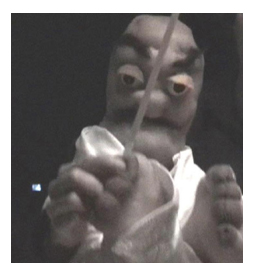
There is much more I can say, but I hope that I have hinted at the way in which each of us is like my little fabric and pipe cleaner dancer. At first you feel very state-oriented. Then, to become an animator, all you have to do is notice the slight movement that is trying to come to birth; the tendency about to happen. And with an animator’s mind, help the dance unfold.

i Quantum Mind, Lao Tse Press, Portland, Oregon, 2000. See Chapter 11 “Calculus and Enlightenment”
pp. 137-150.
ii P. 142.
iii I write much more about process work and the creative process in my book The Dreaming Source of
Creativity, Lao Tse Press, Portland, Oregon, 2005.
8


